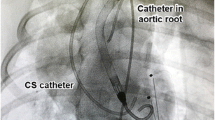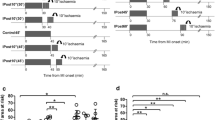Summary
Contractile dysfunction of reversibly injured, reperfused myocardium can be enhanced by inotropic interventions. A decrease in the Ca-sensitivity of contractile proteins with slow recovery during reperfusion has been suggested as a potential mechanism underlying this postischemic dysfunction. We therefore tested the effects of the cardiotonic agent AR-L 57 (1 mg/kg i.v.) in six anesthetized, vagotomized dogs during constant atrial pacing at 192±6 beats/min. Before ischemia, AR-L 57 increased left ventricular pressure from 131±22 to 138±21 mm Hg and maximum dP/dt from 3,022±1,427 to 4,337±2,608 mm Hg/s. Mean systolic thickening velocity of the posterior myocardium was increased from 8.9±1.1 to 11.7±1.1 mm/s. After release of a 15 min LCX-occlusion which caused complete regional akinesia, baseline function in the posterior myocardium was severely depressed and only gradually returned towards control values over 8 h of reperfusion. AR-L 57 increased systolic thickening velocity at 10 min, 4 and 8 h reperfusion to a similar extent as before ischemia. With reference to a purported Ca-sensitizing mechanism underlying the positive inotropic action of AR-L 57, our data suggest no change in the Ca-sensitivity of reperfused myocardium.
Similar content being viewed by others
References
Becker LC, Levine JH, DiPaula AF, Guarnieri T, Aversano T (1986) Reversal of dysfunction in postischemic stunned myocardium by epinephrine and postextrasystolic potentiation. J Am Coll Cardiol 7:580–589
Belz GG, Nübling H, Zimmer A (1976) Investigation of the pharmacodynamics and pharmacokinetics of 2-(2, 4-dimethoxyphenyl)-imidazo-(4, 5-b)-pyridine hydrochloride (AR-L 57 Cl) in man. Europ J Clin Pharmacol 10:319–324
Bolli R, Zhu WX, Myers ML, Hartley CJ, Roberts R (1985) Beta-adrenergic stimulation reverses postischemic myocardial dysfunction without producing subsequent functional deterioration. Am J Cardiol 56:964–968
Braunwald E, Kloner RA (1982) The stunned myocardium: prolonged, postischemic venticular dysfunction. Circulation 66:1146–1149
Bush LR, Buja LM, Samowitz W, Rude RE, Wathen M, Tilton GD, Willerson JT (1983) Recovery of left ventricular segmental function after long-term reperfusion following temporary coronary occlusion in conscious dogs: Comparison of 2- and 4-hour occlusions. Circ Res 53:248–263
Ciuffo AA, Ouyang P, Becker LC, Levin L, Weisfeldt ML (1985) Reduction of sympathetic inotropic response after ischemia in dogs. Contributor to stunned myocardium. J Clin Invest 75: 1504–1509
DeBoer LWV, Ingwall JS, Kloner RA, Braunwald E (1980) Prolonged derangements of canine myocardial purine metabolism after a brief coronary artery occlusion not associated with anatomic evidence of necrosis. Proc Natl Acad Sci USA 77:5471–5475
Diederen W, Kadatz R (1981) Comparative cardiovascular effects of three benzimidazole derivatives, AR-L 57 BS, AR-L 100 BS, and AR-L 115 BS Drug Res 31:141–146
Ellis SG, Wynne J, Braunwald E, Henschke CI, Sandor T, Kloner RA (1984) Response of reperfusion-salvaged, stunned myocardium to inotropic stimulation. Am Heart J 107:13–19
Guth BD, Martin JF, Heusch G, Ross J Jr (1987) Regional myocardial blood flow, function and metabolism using phosphorus-31 nuclear magnetic resonance spectroscopy during ischemia and reperfusion in dogs. J Am Coll Cardiol 10:673–681
Hayes JS, Bowling N, Boder GB, Kauffman R (1984) Molecular basis for the cardiovascular activities of amrinone and AR-L 57. J Pharmacol Exp Ther 230:124–132
Hayes JS, Wyss VL, Wilson H, Pollock GD (1985) A comparison of the cardiotonic effects of AR-L 115 and AR-L 57: evidence for distinct inotropic mechanisms. J Cardiovasc Pharmacol 7:182–189
Herzig JW, Feile K, Rüegg JC (1981) Activating effects of AR-L 115 BS on the Ca2+ sensitive force, stiffness and unloaded shortening velocity (Vmax) in isolated contractile structures from mammalian heart muscle. Drug Res 31:188–191
Heusch G, Guth BD, Roth DM, Seitelberger R, Ross J Jr (1987) Contractile responses to sympathetic activation after coronary instrumentation. Am J Physiol 252:H1059-H1069
Heusch G, Frehen D, Schulz R, Thämer V (1987) Contractile reserve of stunned myocardium: no evidence for impaired sympathetic neurotransmission. Physiologist 30:155 (abstr.).
Hendrickx GR, Millard RW, McRitchie RJ, Maroko PR, Vatner SF (1975) Regional myocardial functional and electrophysiological alterations after brief coronary artery occlusion in conscious dogs. J Clin Invest 56:978–985
Heyndrickx GR, Baig H, Nellens P, Leusen I, Fishbein MC, Vatner SF (1978) Depression of regional blood flow and wall thickening after brief coronary occlusions. Am J Physiol 234:H653-H659
Hoffmeister HM, Mauser M, Schaper W (1985) Effect of adenosine and AICAR on ATP content and regional contractile function in reperfused canine myocardium. Basic Res Cardiol 80:445–458
Honerjäger P, Reiter M, Baker PF (1980) Inhibition of the sodium pump in squid axons by the cardioactive drug AR-L 57. Mol Pharmacol 17:350–355.
Ito BR, Tate H, Kobayashi M, Schaper W (1987) Reversibly injured, postischemic canine myocardium retains normal contractile reserve. Circ Res 61:834–846
Jennings RB, Schaper J, Hill ML, Steenbergen C Jr, Reimer KA (1985) Effect of reperfusion late in the phase of reversible ischemic injury. Changes in cell volume, electrolytes, metabolites, and ultrastructure. Circ Res 56:262–278
Kusuoka H, Porterfield JK, Weisman HF, Weisfeldt ML, Marban E (1987) Pathophysiology and pathogenesis of stunned myocardium. J Clin Invest 79:950–961
Lavallee M, Cox D, Patrick TA, Vatner SF (1983) Salvage of myocardial function by coronary artery reperfusion 1, 2, and 3 hours after occlusion in conscious dogs. Circ Res 53:235–247
Lues I, Siegel R, Harting J (1988) Effect of isomazole on the responsiveness to calcium of the contractile elements in skinned cardiac muscle fibres of various species. Eur J Pharmacol 146:145–153
van Meel JCA (1987) Effects of some cardiotonic agents on contractility of skinned fibers from mammalian heart. Drug Res 37:679–682
Mehmel HC, Mäurer W, Tillmans H, Zebe H, Kübler W (1977) Eine neue Substanz mit positiv inotroper Wirkung und guter Steuerbarkeit für die Intensivmedizin: AR-L 57 Cl. Verh Dtsch Ges Inn Med 83:1685–1687 (abstr.)
Mercier JC, Lando U, Kanmatsuse K, Ninomiya K, Meerbaum S, Fishbein MC, Swan HJC, Ganz W (1982) Divergent effects of inotropic stimulation on the ischemic and severely depressed reperfused myocardium. Circulation 66:397–400
Müller-Beckmann B, Freund P, Honerjäger P, Kling L, Rüegg JC (1988) In vitro investigations on a new positive inotropic and vasodilating agent (BM 14, 478) that increases myocardial cyclic AMP content and myofibrillar calcium sensitivity. J Cardiovasc Pharmacol 11:8–16
Osakada G, Hess OM, Gallagher KP, Kemper WS, Ross J Jr (1983) End-systolic dimension-wall thickness relations during myocardial ischemia in conscious dogs. Am J Cardiol 51:1750–1758
Pouleur H, Gurné O, Hanet C, Balasim H, van Mechelen H, Charlier AA (1988) Effects of pimobendan (UD-CG 115) on the contractile function of the normal and “postischemic” canine myocardium. J Cardiovasc Pharmacol 11:100–106
Reimer KA, Jennings RB, Tatum AH (1983) Pathobiology of acute myocardial ischemia: metabolic, functional and ultrastructural studies. Am J Cardiol 52:72A-81A
Rüegg JC (1986) Effects of new inotropic agents on Ca-sensitivity of contractile proteins. Circulation 73 suppl 3:78–84
Salzmann R, Bormann G, Herzig JW, Markstein R, Scholtysik G (1985) Pharmacological actions of APP 201-533, a novel cardiotonic agent. J Cardiovasc Pharmacol 7:588–596
Schipke J, Heusch G, Schulz R, Thämer V (1987) An easy and quick implantation procedure for the measurement of myocardial wall thickness using sonomicrometry. Basic Res Cardiol 82:411–414
Scholtysik G, Salzmann R, Berthold R, Herzig JW, Quast U, Markstein R (1985) DPI 201-106, a novel cardiotonic agent. Combination of cAMP-independent positive inotropic, negative chronotropic, action potential prolonging and coronary dilatory properties. Naunyn-Schmiedelberg's Arch Pharmacol 329:316–325
Scholz H, Meyer W (1986) Phosphodiesterase — inhibiting properties of newer inotropic agents. Circulation 73 suppl 3:99–108
Solaro RJ, Rüegg JC (1982) Stimulation of Ca++ binding and ATPase activity of dog cardiac myofibrils by AR-L 115 BS, a novel cardiotonic agent. Circ Res 51:290–294
Swain JL, Sabina RL, McHale PA, Greenfield JC Jr, Holmes EW (1982) Prolonged myocardial nucleotide depletion after biref ischemia in the open-chest dog. Am J Physiol 242:H818-H826
Theroux P, Ross J Jr, Franklin D, Kemper WS, Sasayama S, (1976) Regional myocardial function in the conscious dog during acute coronary occlusion and responses to morphine, propranolol, nitroglycerin and lidocaine. Circulation 53:302–314
Theroux P, Ross J Jr, Franklin D, Kemper WS, Sasayama S (1976) Coronary arterial reperfusion III. Early and late effects on regional myocardial function and dimensions in conscious dogs. Am J Cardiol 38:599–606
Weiner JM, Apstein CS, Arthur JH, Pirzada FA, Hood WB Jr (1976) Persistence of myocardial injury following brief periods of coronary occlusion. Cardiovasc Res 10:678–686
Author information
Authors and Affiliations
Rights and permissions
About this article
Cite this article
Heusch, G., Schäfer, S. & Kröger, K. Recruitment of inotropic reserve in “stunned” myocardium by the cardiotonic agent AR-L 57. Basic Res Cardiol 83, 602–610 (1988). https://doi.org/10.1007/BF01906954
Received:
Issue Date:
DOI: https://doi.org/10.1007/BF01906954




